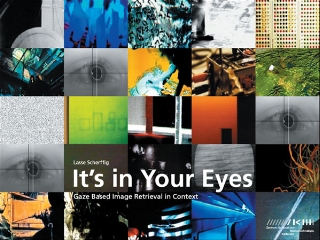Content Description
The interface through which visual media are accessed are the eyes of the observer. In turn, the interface through which a medium may access its observer are her eyes, too. EyeVisionBot uses this input/output duality of vision by incorporating gaze into a computer interface. Its aim is allowing users to search for images by looking at images.
EyeVisionBot has been build as an interactive art installation for the media museum of the ZKM | Center for Art and Media. The base on which the system is build comprises eye tracking technology, content based image retrieval and interaction design. The book "It's In Your Eyes", however, does not solely cover the system in terms of hardware, software and design but pays much attention to both its cultural context and impact.
To do so, it is organized in three chapters carrying the titles "art", "science" and "interface". Each chapter contains a section on the historic role of eye tracking in the particular field and two more sections discussing relevant ideas and developments from those fields that touch and are touched by EyeVisionBot.
Among these are discussions of the role of interactivity in media art, of closed circuit art, of the idea of objective information aesthetics, of current trends in information retrieval and visualization and finally a broad discussion of the interface concept. The latter first is defined recurring on several relevant authors (such as Donald Norman, Brenda Laurel, Terry Winograd and Matthew Fuller) paying special attention to the differences between their respective theoretical conceptualizations of the interface. This analysis discloses a trajectory reaching from seeing interfaces as a point of psychophysical interaction towards a designed surface, a space for communication and finally interface as everything. Subsequently, Michel Foucault's book "Discipline and Punish" serves as the theoretical background on which Human Computer Interaction is redefined and criticized. The computer science practices of creating scenarios and use cases as well as the method of user modeling, it is argued, model users in the sense of defining their behavior. Interfaces, in fact, generally do so and generally may be identified with Foucaultian cases of discipline and punishment. Systems of algorithmic surveillance in this course are put into relation to interfaces in general and EyeVisionBot in particular.
In spite of the structural division into three main topics numerous links between distinct parts of the book are drawn. Closed circuit art (by Bruce Nauman and Peter Weibel), for instance, serves as the link between the scientific ideas of traditional cybernetics, media art, surveillance and Human Computer Interaction.
Contents
0 Introduction
0.1 A Method Against Method
0.2 Eye-Vision-Bot
0.3 The Eye
1 Art
1.1 Eye Tracking as Art
1.2 Closed Circuits
1.3 Aesthetics and Information
2 Science
2.1 Eye Tracking as Science
2.2 Searching Images
2.3 Adaptive Agents and Data Mining
3 Interface
3.1 Eye Tracking as Interface
3.2 Interface?
3.3 Interface!


